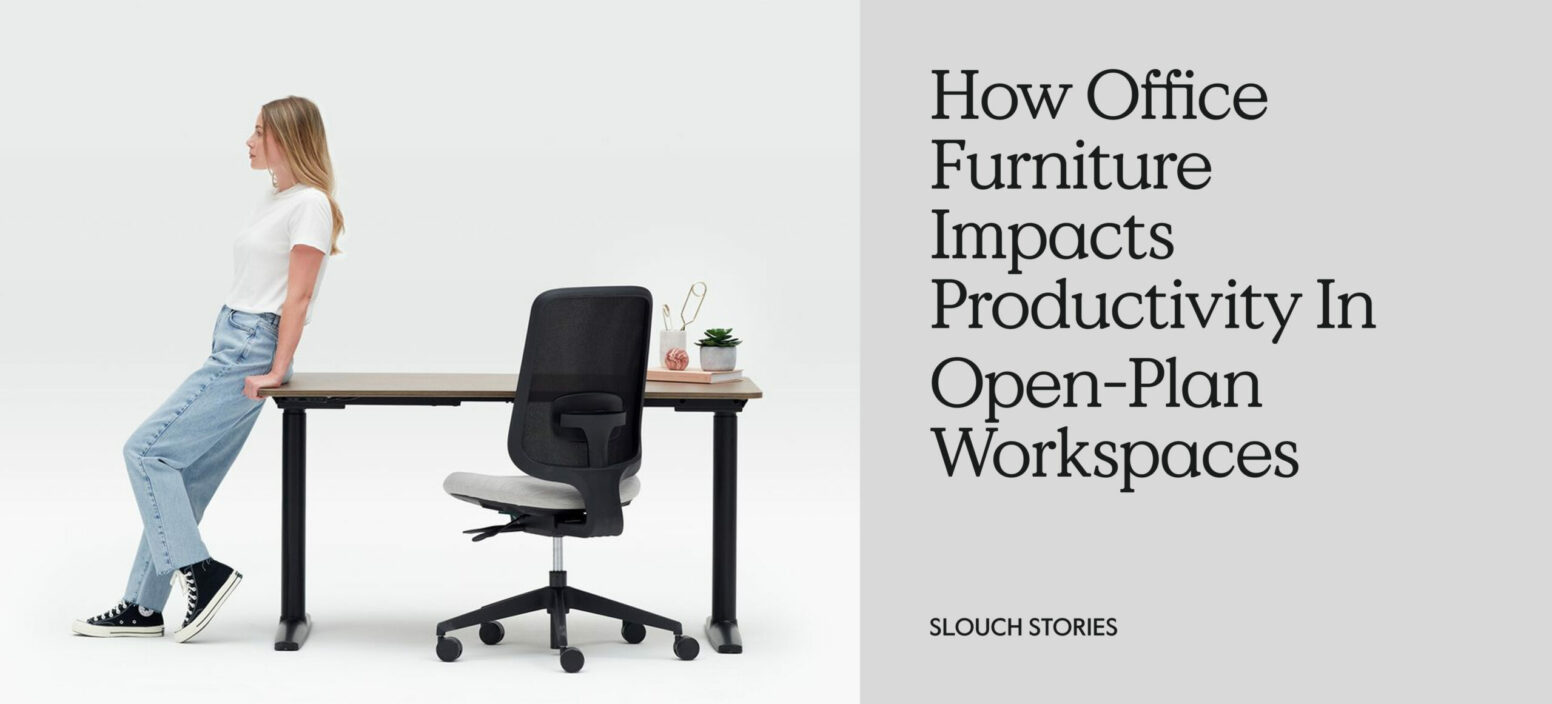Open-plan offices are designed to bring people together. They’re collaborative, flexible and cost-effective, which is why they’re still the number one layout choice for offices around the world.
But if you’ve ever worked in an open-plan office, you’ll also understand their drawbacks. The noise, the uncomfortable furniture, the glaring overhead lights. It’s just not really an environment that makes for good work output.
As the experts in quality office furniture design, we’ll explain exactly how your office furniture affects productivity in an open-plan work environment, as well as what you can do to improve it.
What do we mean by posture & why does it matter?
Posture means the position you sit or stand in. Good posture is when your entire body is properly aligned. This is when your head is positioned properly over your shoulders, your spine follows its natural curve, and your weight is evenly distributed across both feet.
However, when your body is misaligned, you get bad posture. This doesn’t just mean you look hunched over or less professional – it causes strain and pain and can even lead to long-term musculoskeletal conditions.
Offices are a breeding ground for bad posture because we spend so long working at office furniture that doesn’t necessarily fit our bodies well. That forces us to adapt using bad posture. That’s why it’s important to ensure that you’re actively working to improve your posture and the environment that either helps or hinders it.
Ergonomics and comfort
Comfort is the foundation of productivity, which is why we spend so much time testing and re-testing our office chairs. If you’re constantly shifting in your seat to ease your back pain or regularly need to stretch your legs, you’re not giving your full attention to your work and your productivity will likely suffer.
Ergonomic chairs with adjustable lumbar support, variable height settings and armrests provide the kind of long-lasting comfort you need to work at your best. In fact, one study by the Journal of Occupational and Environmental Medicine (2014) found there was a 17.7% increase in productivity when employees used ergonomic furniture.
When you’re not distracted by back pain that’s caused by an unsupportive and uncomfortable chair, you’re able to concentrate better without distractions (although we can’t erase your neighbouring chatty coworker).
Furniture layout
Have you ever stopped to think about how the layout of an office can impact how you work? No one wants to work in a space that’s chaotic or cluttered, or in an arrangement that requires a map to get around.
The furniture should be positioned in such a way that creates balance. It should work for those who want to concentrate, as well as for those who want to collaborate with other team members.
A survey from Gensler actually revealed that fewer people want to collaborate in traditional conference rooms or a stand-up meeting space and more people want flexible co-working spaces and comfortable rooms with soft seating, like sofas.
The furniture in these kinds of rooms is going to be make-or-break, and adjustable desks and chairs will be your best friend. These will allow you to maximise the office space, turning a soft-sit room into one with standing desks that can easily be pushed aside after use.
For the main open-plan office, you may want to consider the general layout. Whether it’s rows of desks, clusters in a circle or a more dynamic arrangement, the goal is the same — to create a workspace that supports focus when needed but also makes teamwork effortless.
The flow of traffic should be considered, too, creating a layout that is easy for people to move around with minimal disruptions.
How else can I create a comfortable home office?
While posture is crucial for comfort, there’s more you can do to make sure the space you’re working from is set up properly for you. Here are some top tips for creating a supportive workspace:
- Read our handy guide on how to create a truly ergonomic home office to find out what to include in your setup.
- Make sure you’re using task lighting to avoid eye strain, and while you’re at it make sure you’ve got a blue light filter in your glasses if you wear them – it can really help if you have to use a computer for extended periods of time.
- Keep your essentials in reach and organised so you don’t have to constantly reach around, breaking your focus and causing you to twist your back. These little things can really add up.
Personalisation
No two people work in exactly the same way, or even sit in exactly the same way.
Have you ever sat in the car after your partner has driven it and the mirrors are all over the place, the seat feels wrong and they’ve changed your favourite radio station. Annoying, right? The same principle applies to workspaces.
Adjustable chairs and desks allow you to set up your workstation in a way that suits you, from seat depth to desk height. A good office chair should let you fine-tune the seat height so that your feet rest flat on the floor and your knees are at a comfortable 90-degree angle. The seat depth is equally important, so check that the backs of your knees aren’t pressing against the edge of the chair.
Lumbar support is another key feature. You should be able to position the height and depth of the lumbar support so that it maintains the natural curve of your spine when you’re sitting down.
Desks can benefit from adjustability too. A sit-stand desk lets you alternate between sitting and standing throughout the day to reduce stiffness, improve circulation and keep your energy levels up. For standard desks, adjustable height settings make it easier to align the work surface with your elbows so you can type without hunching or straining.
On top of this, personal touches such as photos or plants can help you to feel more comfortable and ‘at home’ at your desk, which in turn supports performance and wellbeing.
Design and atmosphere
According to Gensler’s Global Workplace Survey 2025, 62% of employees felt that their workplace experience needed improving. When this is the case, you might feel demotivated, uninspired and short on creative energy as soon as you step foot in the office.
So how do you fix this?
Inject some colour, fun and atmosphere into the space as best as you can!
There’s this idea that office furniture that looks attractive isn’t supportive or practical, but it doesn’t just have to be functional (say it louder for those in the back).
When you have a team of designers who make it their mission to create stylish office chairs and desks, you can be comfortable as well as having a beautiful work environment. Our chairs come in a range of colours, from grey and blue to pink so you can pick the one that speaks to you the most.
Apply some of your favourite colours to your desk, be it through artwork or framed photos. Plants are a wonderful way to add some colour too, plus there’s the added bonus that they can improve your concentration and lift your mood.
Even subtle design choices, such as fabric textures, wood tones, or metal frames can take an office from feeling corporate and sterile to welcoming and inspiring.
Sounds
Noise is generally the biggest productivity challenge in open-plan offices. Coworkers stop for a chat, phones are ringing, people are in and out of meeting rooms, there seems to be some sort of confab happening in the kitchen. It’s all distracting.
For maximum productivity, it’s important to think about how you can dull the noise of an open office. Sound-insulating screens, acoustic panels and work pods create quieter spaces for those that want to concentrate.
Pod rooms allow for group discussions that don’t need to take place in the main office. They’re also an ideal space for you to sneak off to when you have a deadline and want to get your head down with no distractions.
When paired with adjustable furniture, these quieter spaces can be tailored to each user’s needs, making them ideal for both group work and individual focus.
In open-plan offices, where distractions are inevitable and concentration withers away, the right office furniture is more than just a practicality. It’s a necessity, and it directly influences comfort, organisation, focus and even the atmosphere of the workplace.
Ergonomic and adjustable furniture supports long-term health, while smart layouts, personalisation and the right acoustics ensure you can simply do what you’re there to do.

